Welcome back to another edition of ‘the crumbs’ – a summing up of what went on in the kitchen on into the belly at What’s Cooking HQ, which books were eyeballed and a new section, where I geek out over a particular edible plant that may also be growing wild in your area.
I’m very glad to have you here.
No preamble this month. Let’s hop straight to it.
What was cooking in March
The weather is finally starting to cool down and it’s becoming much easier to get back into the kitchen. As I type this, I have a stock simmering on the hob, a beetroot and cabbage sauerkraut fermenting on the counter and plans to make a delicious tofu curry tonight. This is the kind of cooking I love.
Plus – it’s harvest season! I wrapped up my foraging course the other week, head bursting full of delicious new knowledge. I’ve got a more detailed post on this to come, including what I’ve been harvesting around my ‘hood.
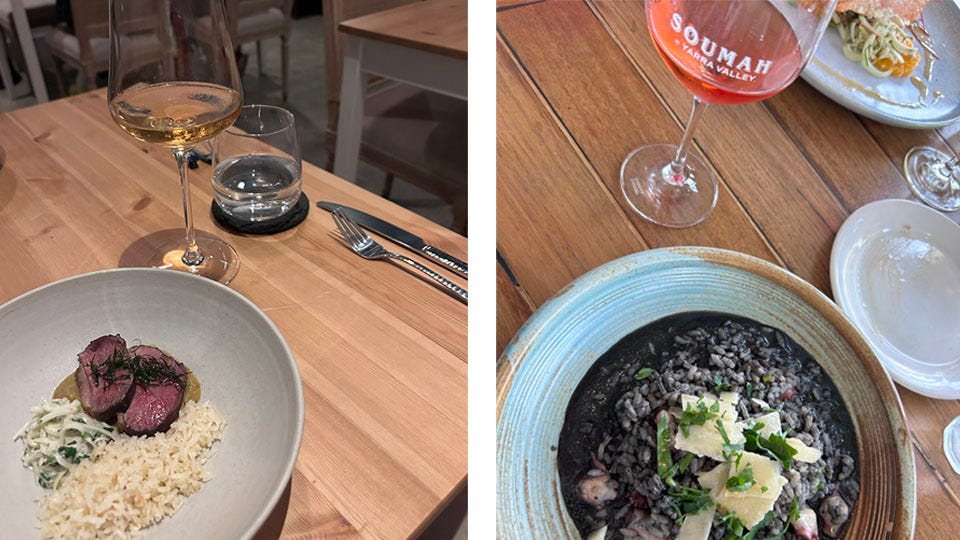
Two excellent meals out this month, within the span of a week as well. The first was at Soumah of Yarra Valley, specifically within their Ai Fiori Trattoria, which a trusted source reported on as being darn good a few years ago. Journeyed there with some overseas pals who were in town and wasn’t disappointed. I had a glass of their rosata and Risotto al nero di seppia, or ‘squid ink risotto’. Nom, nom. This was followed by an evening spent dining at Indian restaurant Enter Via Laundry, in Carlton North. Chef Helly Raichura originally fed guests in her home – who had to enter via her laundry. The menu showcases traditional regional Indian dishes, re-imagined with native Australian ingredients. Hands down one of the best meals I’ve had in Melbourne. Helly also recently released a cookbook, The Food of Bharat, which I’m keen to add to my collection.
The bottle of the month award goes to False Cape Wine’s 2019 ‘The Captain’ Cab Sav, enjoyed after a very productive weekend of unpacking and general life-related organisation in late March. It’s made on Kangaroo Island, to boot.
Melbourne Food and Wine Festival is also currently in full swing, but as it’ll only be halfway through as it as this missive sends out, I’ll report back on the events I’m excitedly attending next month.
What was booking in March
March was a bit of a slow reading month at first, then picked up towards the end. Many nights of reading one or two pages on my Kindle, before falling into the land of nod.
Books read
American Wife by Curtis Sittenfeld (owned)
I’ve been wanting to read this for a very long time, basically since I first picked up Rodham, her ‘fictional’ book about Hilary Clinton. American Wife is loosely based on the life of Laura Bush and it’s not as… cringe I guess I’d say. This is because, I guess for legal reasons, characters within the novel have been renamed while borrowing from elements of the Bush’s lives, so you weren’t having to read words that directly described the process of Laura and George W. getting it on. Thank goodness. Overall, I enjoyed the story and it was particularly interesting to visit that wrinkle in time that is the early 2000s which wasn’t too long ago but honestly feels like another lifetime.
Signs of Damage by Diana Reid (borrowed)
Signs of Damage starts with a death and is marketed as a summer noir. A wedding in Tuscany has been disrupted by someone falling off a balcony – we won’t discover who until the very end of the novel. This death is not the central catalyst propelling the story along; rather it’s the conclusion to a traumatic event that took place in 2008, during a summer in France. 13 year old Cass has journeyed there with her troubled friend Anika, along with Anika’s parents Bruce and Vanessa and older sister Skye. Bruce’s childhood friend Harry and Sam, and writer neighbour Rupert make up the rest of the cast. Shifting perspectives and fragmented truths confuse things further, leading to a conclusion that is never really finalised and despite the fall, never quite lands.
What I Ate in a Year by Stanley Tucci (library)
Stanley Tucci to me, seems like a sweetheart and I’ve only been further endeared to him through reading his books. Set in diary form, What I Ate in a Year is, as the title suggests, a year in the life of Tucci, outlining what he and his family have cooked, where they’ve dined and who they’ve dined with. It’s a delicious glimpse into how the famous live; he might be dining with Sam Rockwell or Colin Firth in London, hanging out in the English countryside with the Blunt/Krasinski’s or visiting Guy Ritchie’s impressive sprawling property. Interspersed are odd recipes too – nothing too hectic, just nourishing meals that would be perfectly simple to replicate in your own kitchen.
Dream Count by Chimamanda Ngozi Adichie (owned)
I’ve been waiting a long time for a new book by CNA and Dream Count didn’t disappoint. It follows four women, living very different lives. All are connected in some way to Nigerian travel writer Chiamaka, who is living alone in America during the pandemic, pulling apart her past loves and losses. Zikora is her best friend, a laywer who has only ever known success and is falling apart at the seams. Her cousin, financial boss-woman Omelogor is stuck doing some deep soul-searching and housekeeper Kadiatou is facing her biggest hurdle yet.
Books bought
Breath by James Nestor (eReader)
Digital Minimalism by Cal Newport (eReader)
Dream Count by Chimamanda Ngozi Adichie (hard copy)
Stag Dance by Torrey Peters (hard copy)
Currently reading:
Down the Drain by Julia Fox (audio book)
Orbital by Samantha Harvey (library copy)
Digital Minimalism by Cal Newport (eReader)
Plant profile: Nasturtium
Kicking off a year-long examination of certain plants and ‘weeds’ with a favourite.
Nasturtiums are fairly abundant in my neck of the woods, growing in gardens, peeking under fences and sowing themselves into the ‘wilds’ of the city. And the best thing about them is, you can eat the whole plant. Yup, the flowers, leaves, stems and seeds can all be harvested for eating. Nastutrium is said to be rich in Vitamin C and it’s just a gorgeous looking plant. What’s not to love?
When harvesting, choose flowers at their peak, and take small or large leaves, depending on your intended use. If foraging, make sure you wash everything thoroughly and properly, removing any soil and bugs that may be clinging to the plant.
And what does nasturtium taste like? A bit peppery, which can taste either mild, or be quite intense, depending on your palate. The flowers generally have a stronger taste than the leaves, or merely the petals themselves.
I recommend having a bit of a nibble on a leaf, before you go mad with adding nasturtiums to various dishes.
And how can you cook with nastutrium?Here are some ideas:
add leaves to a salad
top pizza with it instead of rocket (or arugula as it’s known in the US)
pop the leaves into a green smoothie
use the flowers to decorate cakes/salads
chop stems and leaves and fold into an omelette
eat leaves/petals on a slice of toast with cream or cottage cheese
make a pesto out of the leaves
stir-fry the leaves
stuff the flowers and use the large leaves as wraps
infuse a vinegar with the leaves and flower
dry the flowers and leaves, then crush and mix with sea salt, to add a peppery flavour to seasoned dishes
pickle the young seed pods and use them as a replacement for capers
cut up the stems to use as a replacement for chives as a herb or garnish.
use the petals to decorate a drink (nasturtium margarita, anyone?) or a soup.
Next month’s plant will be the very useful and oft’ ignored misclassified ‘weed’ dandelion.
In case you missed it
Here’s what was published on What’s Cooking in March.
Autumn is the perfect time for road tripping. I share some of my favourite road trip books below.
Here’s a very quick guide to a few places to eat in Lakes Entrance, a waterside town in Victoria’s east.
And sharing a recently conducted experiment into ‘sit-spotting’. This is a practice where you find a spot in nature to return to, to meditate and observe the world around you. One of my favourite posts of recent times and I hope you enjoy it too.
That’s it for this month. Take care and I’ll catch you next week.
‘Til then, stay well, well-fed and especially well-read.
-Celine
Thanks for reading! If you enjoy this newsletter, it helps quite a lot if you hit 💚or even leave a comment – or forward it on to a like-minded friend.
Explore crumbs of the past:
As this edition contains notes about wild foraging, I must state that I am not a nutritionist, dietician or any sort of medical expert. As with any kind of urban foraging, proceed with caution and consume at your own risk – What’s Cooking with Celine cannot take responsibility for any reader becoming ill after eating wild food.

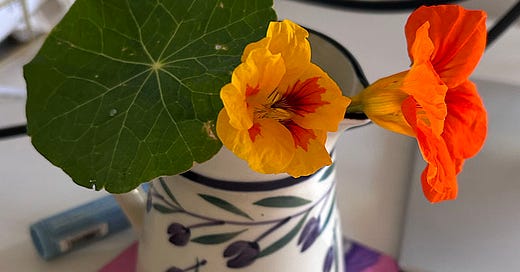




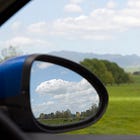
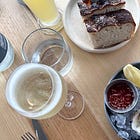

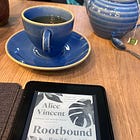


Great reading this time, as usual! Nice to revisit Soumah and learn more about nasturtiums too.
Love this latest collection of Crumbs! Such great info on garden foraging, and your book pile is as eclectic as ever. Fascinating :D